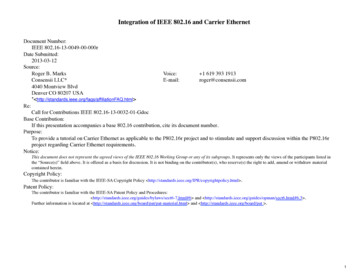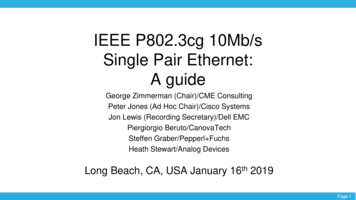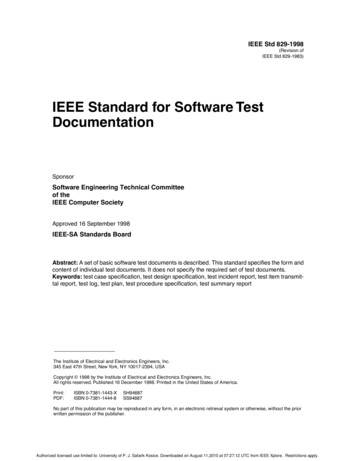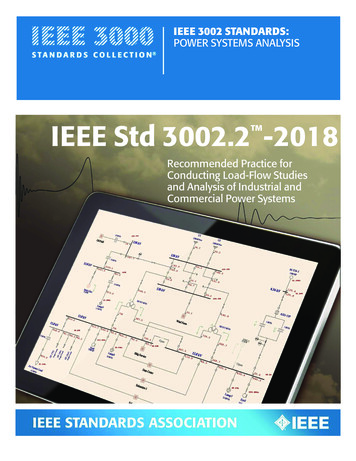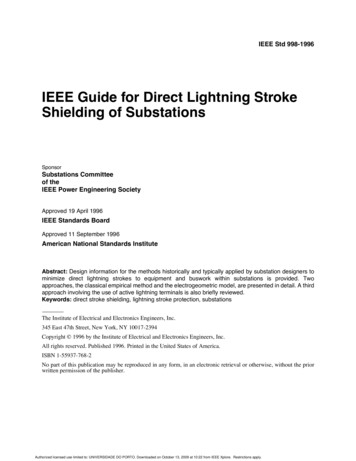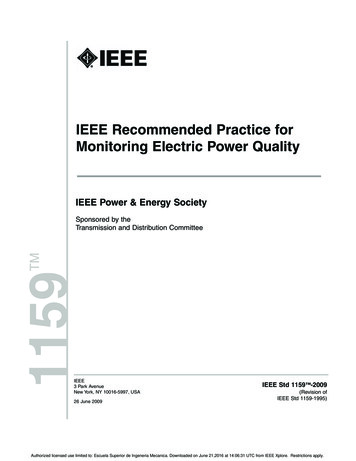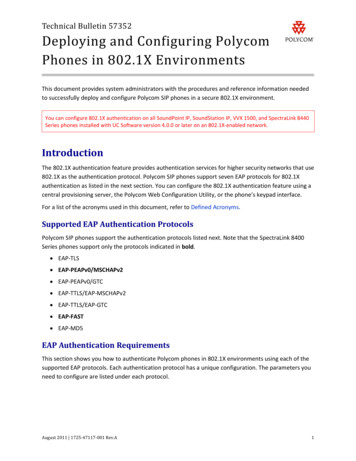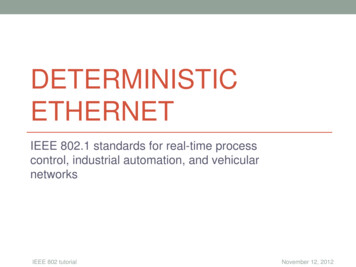
Transcription
DETERMINISTICETHERNETIEEE 802.1 standards for real-time processcontrol, industrial automation, and vehicularnetworksIEEE 802 tutorialNovember 12, 2012
Deterministic EthernetContents History, markets and use cases Time synchronization on networks Quality of Service Shortest Path Bridging Mixed-technology networking This presentation with animations is available tutorial-Deterministic-Ethernet-1112.ppt2
Deterministic Ethernet3HISTORY, MARKETS ANDUSE CASESOliver KleinebergBelden / Hirschmann Automation & ControlIEEE 802 tutorialNovember 12, 2012
Deterministic Ethernet – History, markets and use cases4History and Emerging Markets Early adopters outside IT: Industrial Automation ( 1990s) Higher Bandwidth than Fieldbusses(legacy automation network technologies, e.g. Profibus, Interbus, ) Convergence with IT services Widely available silicon could largelybe re-used Micro-Segmentation / Fully switchednetworks introduced first„deterministic Ethernet“ Easy fibre adoptionManufacturing shop floorAutomation Pyramid
Deterministic Ethernet – History, markets and use cases5History and Emerging Markets Early adopters outside IT: Professional and Home Audioand Video (early to mid 2000‘s) High Performance Good Price / Performance High flexibility in wiring and media Easily merges with existing home entertainment networks andWireless LANs In 2005, work in IEEE 802.3 (Residential Ethernet) started Latermoved to IEEE 802.1 as Audio and Video BridgingConverged home networkedservices: File storage VoIP Audio and Video transmission(on demand)(*) Source: WikipediaLive Performances(*)Home Theater PC(*)
Deterministic Ethernet – History, markets and use casesHistory and Emerging Markets Existing Technologies: IEEE and Non-IEEE IEEE 802.1 Audio and Video Bridging Of high interest in Professional and Home Audio and VideoTime Synchronization based on well-proven IEEE 1588 protocolBandwidth Reservation and Class-based QoS (Traffic Shaping)Deterministic Real-Time Ethernet technology that fits the original use case very wellAlready applicable to some of the emerging new market applicationsIEEE 802.1 Shortest Path Briding Providing resiliency to failures in the network infrastructure Where no IEEE standards were available, other specificationsemerged, often driven by proprietary technologies:Proprietary protocols for Professional Audio (e.g. Cobranet)Proprietary protocols for Industrial Automation (e.g. ISO/IEC addressingRedundancy and Real-Time in ISO/IEC 62439 / 61158 / 61784 series) Application-specific extensions of standard IEEE 802 technologies (e.g. ARINCAvionics Full-Duplex Switched Ethernet - AFDX) High demand for a converged IEEE 802 solution for deterministicEthernet to replace proprietary technology and fit the needs of existing andemerging markets.6
Deterministic Ethernet – History, markets and use cases7History and Emerging Markets Emerging Markets: Mission-critical networking Emerges out of Industrial Automation, massively broadening thescope Requirements (far) beyond standard IT equipment relating todeterminism in time and protocol behaviour Often used as transparent communication channel for End-to-EndSafety Communication Risk for Life and Limb if the system fails – High requirements tooverall network, protocol and device robustnessPower Utility Automation Traffic Control SystemsTransportation
Deterministic Ethernet – History, markets and use cases8Use Case: Mission-critical Automation Railway: Rolling stock Ethernet in trains hasapplications in customerinformation and alsoinfotainment Another application area lies in traincontrol networks and video surveillance as well as passenger counters anddetectors on the automatic train doors
Deterministic Ethernet – History, markets and use cases9Use Case: Motion ControlWind turbine: Synchronized rotorblade control actuatorsApplications where robots and humansclosely interact: Robot-assisted manufacturing Robot-assisted surgery Robotic prostheses Printing machine: Largenumber of synchronizedaxles
Deterministic Ethernet – History, markets and use casesHistory and Emerging Markets Emerging Markets: Vehicular Networks Reduced Wiring Harness Reduced weight and cabling costs Reduce overall costs by using standardized chips Reduce risks of binding to one silicon/solution vendor Unified solution for different application areas (e.g. Infotainment,Power Train, Driver Assistance, )Picture Sources: IEEE 802.3 RTPGE SG10
Deterministic Ethernet – History, markets and use casesUse Case: Vehicular NetworkOne possible application example of a future vehicular networkSource: IEEE 802.1 AVB TG presentation11
Deterministic Ethernet – History, markets and use casesHistory and Emerging Markets One Step further - Added Requirements for a convergedIEEE solution for Deterministic Ethernet: There are many requirements already covered by 802.1 AVB and other IEEE 802 solutions, but the scope has broadenedNeed to support larger network structures (long daisy-chains,interconnected rings )Very High EM resistance and low weight/cost of PHY‘s(see RTPGE)Very low latency and jitter, exceeding the original AVB scopeSeamless fault-toleranceResilient Time Synchronization802.1 and 802.3 are currently starting or have already started toaddress these market needs!12
Deterministic Ethernet13TIME SYNCHRONIZATIONON NETWORKSMichael D. Johas Teener, Broadcom CorporationIEEE 802 tutorialNovember 12, 2012
Deterministic Ethernet – Time synchronization on networksAgenda Why do we care? Network time synch fundamentals IEEE 802.1AS What’s next14
Deterministic Ethernet – Time synchronization on networksUses and Requirements Phase/frequency lock for Ethernet emulation ofSDH/SONET architecture must meet ITU specs Event coordination for control and testing industrial / test & measurement Synchronization between multiple media streams 1 microsecond max error in professional use Frequency base for time stamping of audio/videopackets less than 100 ps jitter for uncompressed HD video15
Deterministic Ethernet – Time synchronization on networksThis Is Not Easy IT networks were designed to carry as much informationas possible as reliably as possible Speed was important, efficiency was important, delay minimizationwas important Maintaining synchronization was only a secondary concern (atbest) All concept of “time” was lost in network specificationsexcept for physical layers Delays in buffers and queues were not communicated ormeasured. There was no explicit way for an application to determine when anevent occurred on a remote device without some kind of out-ofband support: WWV, GPS, 1PPS (one pulse per second) cable,IRIG, etc.16
Deterministic Ethernet – Time synchronization on networks17So, How Do We Do It? The key is the measurement of delay which can be done via a packet exchange such as done in NTP(Network Time Protocol)ClientServernetworkOrigin Timestamp: t1clientmsgReceive Timestamp: t2sger mservTransmit Timestamp: t3Destination Timestamp: t4know: t1,t2,t3,t4round trip delay ((t4-t1)-(t3-t2))one-way delay is half ofthe round trip, but only ifdelays are symmetric A client can then use a time value transmitted by a server justby adding the delay
Deterministic Ethernet – Time synchronization on networksThe Magic Is the Time Stamp A timestamp is the value of some timer when a particularevent occurs The more precise and deterministic the event, the better In NTP, it’s not well controlled usually a kernel/driver softwareevent as close to the hardware as possible, only millisecondaccuracy To get better results, we use a physical layer event in Ethernet,that’s the start of packet, sub microsecond accuracy By communicating the value of timestamps at well-knownevents, we can correlate network actions with actual time.18
Deterministic Ethernet – Time synchronization on networksPrecision Time Protocol (PTP) IEEE 1588 standardized the use of physical layertimestamps to compute network delays and definesynchronization events IEEE 802.1AS is a 1588 “profile” with fewer options, and extendedphysical layer options Components Time Distribution Link Delay Measurement Best Master Clock Selection19
Deterministic Ethernet – Time synchronization on networksTwo Step Messaging How do we communicate the time of the start of a packetthat is being transmitted? Send that time in a later packet, the “follow up”, as the “preciseorigin timestamp” It is possible to insert the timestamp into a transmit packet on the fly this iscalled “one step messaging” 20
Deterministic Ethernet – Time synchronization on networksTime Correction in a Bridge Bridges Delays are now relatively constant, since they are just cable delays,without queues or buffers 1588 calls this a “transparent clock”, required in 802.1AS A “correction field” in the FollowUp is incremented by the upstream delay and theresidence time (t3-t2) The correction field plus the precise origin timestamp plus the upstream delay is the correct time21
Deterministic Ethernet – Time synchronization on networksPath Delay Processing Done infrequently since delays are stable22
Deterministic Ethernet – Time synchronization on networksIEEE 802.1AS 802.1AS uses a subset and superset of IEEE 1588v2 Different methods for delay measurement for different L2technologies 802.3 (full duplex) is supported using a very specific profile ofIEEE 1588 f802.3 (EPON), 802.11, and generalized CSN’s (coordinatedshared networks) are supported by new specifications Includes performance specifications for bridges as“time aware systems” Uses accumulated “neighbor rate ratio” calculations toimprove accuracy and speed up convergence Includes plug and play operation and startup Requires use of a very specific form of BMCA (Best MasterClock Algorithm) that bridges also use23
Deterministic Ethernet – Time synchronization on networks24802.1AS ArchitectureTime-aware higher-layer application(see clause yncPortSyncLLCLLCMSMSMedia-dependenttime-aware systementitiesMDMAC relay(see IEEE 802.1Q-2005)ISSISSMACMACPHYPHYmedia dependentMDSyncSendMDMedia-dependenttime-aware systementitiesmedia dependentMDSyncReceive(see clauses 11, 12, 13 and annex E)MDSyncSendMDSyncReceive(see clauses 11, 12, 13 and annex E)PortSync
Deterministic Ethernet – Time synchronization on networksBest Master Clock Selection All bridges announce the quality of their clock to theirneighbors The best announcements are propagated Each bridge compares received announcements to theirown clock quality Quality is comprised of (in decreasing order of importance): Priority (configurable) Multiple “clock quality” fields MAC address If “superior” announce messages are received that bridge ceases to announce and adopts the superior bridge as thegrand master If the grand master dies and announce messages cease all bridges announce and a new grand master is quickly chosen25
Deterministic Ethernet – Time synchronization on networksNext Steps (802.1ASbt) Explicit support for one-step processing Backwards compatible to two-step Hot standby for backup GMs Multiple paths for clock propagation Clock path quality metric26
Deterministic Ethernet27QUALITY OF SERVICEChristian BoigerDeggendorf University of Applied SciencesIEEE 802 tutorialNovember 12, 2012
Deterministic Ethernet – Quality of ServiceQuality of Service The requirements on traffic are very different for various applications and types of dataFor some applications it is enough to have strict prioritytransmission selection and low utilizationBut for some types of traffic with high QoS demands it isnot enough to be sent before the lower priority trafficAnd some of these applications need guaranteed QoS(e.g. guaranteed very low latency)The “old” IEEE 802.1 QoS mechanisms did not provideguarantees28
Deterministic Ethernet – Quality of ServiceGuaranteed QoS An example for a type of traffic with high QoS requirements are audio/video streamsSome applications need guaranteed low latency for thistype of dataThe network needs low latency (latency buffers)Audio Video Bridging addresses this problemOne part of the solution to achieve the requirements ofaudio/video streams is the combination of: Stream reservation (incl. bandwidth reservation) Traffic shaping Both parts are necessary, in order to provide a latencyguarantee for this type of traffic29
Deterministic Ethernet – Quality of ServiceAudio Video Bridging Audio Video Bridging (AVB) introduced new a type oftraffic classes for audio/video streams SR class A SR class B SR class A traffic has the highest priority in the network The major goals of the AVB QoS features are to: Protect the best effort traffic from the SR class traffic Protect the SR class traffic from best effort traffic Protect the SR class traffic from itself Both AVB QoS mechanisms (stream reservation andtraffic shaping) address these goals30
Deterministic Ethernet – Quality of ServiceStream Reservation The Stream Reservation Protocol (SRP): Advertises streams in the whole network Registers the path of streams Calculates the “worst case latency” Specifies the forwarding rules for AVB streams Establishes an AVB domain Reserves the bandwidth for AVB streams Especially the bandwidth reservation is important in orderto: Protect the best effort traffic, as only 75% of the bandwidth canbe reserved for SR class trafficProtect the SR class traffic as it is not possible to use morebandwidth for SR class traffic than 75% (this is an importantfactor in order to guarantee a certain latency)31
Deterministic Ethernet – Quality of Service32Stream Reservation ExampleListenerReadySR stream ID accumulated latency talker latency frame length interval SSS stream ID accumulated latency bridge latency frame length interval SRSTalkerAdvertiseListenerReadyRRS RS RS RS RS
Deterministic Ethernet – Quality of ServiceTraffic Shaping As audio/video streams require a high bandwidthutilization, it was necessary to set the maximum availablebandwidth for this new traffic class quite high (75%) Therefore the Credit Based Shaper (CBS) was introduced The CBS spaces out the frames as much as possible inorder to reduce bursting and bunching This behavior: Protects the best effort traffic as the maximum interference (AVBstream burst) for the highest best effort priority is limited and known Protects the AVB streams, as it limits the back to back AVB streambursts which can interfere in a bridge33
Deterministic Ethernet – Quality of ServiceCredit Based Shaper34
Deterministic Ethernet – Quality of ServiceFuture Work – Gen2 The stream reservation protocol and Credit Based Shaper allow for a converged network with IT traffic and highpriority SR class traffic (e.g. audio/video streams) withplug and play supportBut as shown before, there are a lot of non audio/videoapplications in the industrial and vehicle control area withhigh QoS requirementsThe QoS requirements of some of these applications can’tbe achieved with the current AVB standardsTherefore 802.1 started new projects to address theneeds of this marketsThese new projects will provide lowest latency forengineered networks35
Deterministic Ethernet – Quality of ServiceScheduled Traffic The latency requirements in the industrial and vehicle control networks imply a significant reduction of latency (compared toAVB Gen1)Therefore it is necessary to prevent from any interference withother lower priority or even same priority trafficTo prevent from any interference, the high priority traffic has tobe scheduledIEEE P802.1Qbv will introduce the Time Aware Shaper to allowfor Scheduled TrafficIn order to enforce the schedule throughout a network, theinterference with lower priority traffic has to be prevented, asthis would not only increase the latency but also the deliveryvariationHence the Time Aware Shaper blocks the non ScheduledTraffic, so that the port is idle when the Scheduled Traffic isscheduled for transmission36
Deterministic Ethernet – Quality of ServiceTime Aware Shaper37
Deterministic Ethernet – Quality of ServiceQoS Summary Audio Video Bridging introduced mechanisms for the convergence of IT networks and audio/video networksAudio Video Bridging guarantees bandwidth for reservedstreams and best effort trafficAudio Video Bridging guarantees a certain latency forreserved streamsScheduled Traffic will provide mechanisms to guaranteeminimum latency for industrial and vehicle controlapplicationsStudying additional improvements for converged networkswhich support all three types of traffic in one network38
Deterministic Ethernet39IEEE 802.1aq –SHORTEST PATH BRIDGINGJános Farkas, EricssonPaul Unbehagen, AvayaDon Fedyk, Alcatel-LucentIEEE 802 tutorialNovember 12, 2012
Deterministic Ethernet – Shortest Path BridgingAcknowledgements Many people contributed to 802.1aq SPB, which isa significant add-on to 802.1Q The editors Don Fedyk and Mick Seaman Major contributors David Allan, Peter Ashwood-Smith, Nigel Bragg,Jérôme Chiabaut, János Farkas, Stephen Haddock,Ben Mack-Crane, Panagiotis Saltsidis and Paul Unbehagen This section also involves their contribution40
Deterministic Ethernet – Shortest Path BridgingSection Contents An insight to IEEE 802.1aq Shortest Path Bridging (SPB) SPB is a control protocol Existing data plane leveragedStandardized by IEEE 802.1 Compatible with other 802.1standards; both backwards and “forward” (due to backwardscompatibility of future standards) The insight involves: A quick look on the data plane Paradigm shift in the control plane Link state for bridges A lot of capabilities Advantages and applications What comes next?41
Deterministic Ethernet – Shortest Path Bridging42MAC BridgeRelayEgress PortIngress PortHigher LayerEntitiesData PlaneExternalAgentControl Plane802.1Q Bridge Architecture –Separated Control and Data PlanesControl Options (details in the coming slides) Even simultaneous control within a network region, e.g.:VLAN space:spanning treeVLANsshortest pathVLANssoftware definedVLANsSPBPBBTraffic EngineeringSpanningControl: MultipleTree ProtocolVirtual Networksseveral overlay combinations are possible;names do not bound applications, e.g.PBB is great for data centersVirtualLAN (VLAN)CustomerVLAN(12-bitC-VID)VID)(12-bitService VLAN(12-bit S-VID)Backbone Service InstanceFrame inFrame out(24-bit I-SID)Backbone VLAN(12-bit B-VID)Uniform forwarding: Destination MAC VLAN ID (VID)network virtualization and QoSProvider Bridges (PB)/“Q-in-Q”/scalability4K VIDproblemsolvedProvider BackboneForgetBridges (PBB)about/“MAC-in-MAC”/4K VIDscalability andproblemseparation16 million24-bit I-SID virtual networks
Deterministic Ethernet – Shortest Path Bridging43Control Plane EvolutionRSTPMSTPRapid Spanning Tree Protocol Multiple Spanning Tree ProtocolSPB RSTP: a single spanning tree shared by all traffic MSTP: different VLANs may share different spanning trees SPB: each node has its own Shortest Path Tree (SPT) We are not limited to shared spanning trees any moreNote: the Spanning Tree Protocol (STP) is historical, it has been replaced by RSTP
Deterministic Ethernet – Shortest Path BridgingSPB in a Nutshell SPB applies a link state control protocol to MAC BridgingBased on the ISO Intermediate System to Intermediate System (IS-IS)intra-domain routing information exchange protocol ISIS-SPB Leverages the automation features of link state, e.g. auto-discovery Preserves the MAC Service model, e.g. delivery in-order ISIS-SPB operation Link state data base Identical replica at each bridge Topology information Properties of the bridges Service information Com
Deterministic Ethernet 6 History and Emerging Markets Existing Technologies: IEEE and Non-IEEE IEEE 802.1 Audio and Video Bridging Of high interest in Professional and Home Audio and Video Time Synchronization based on well-proven IEEE 1588 protocol Bandwidth Reservation and Class-based QoS (Traffic Shaping) Deterministic Real-Ti
